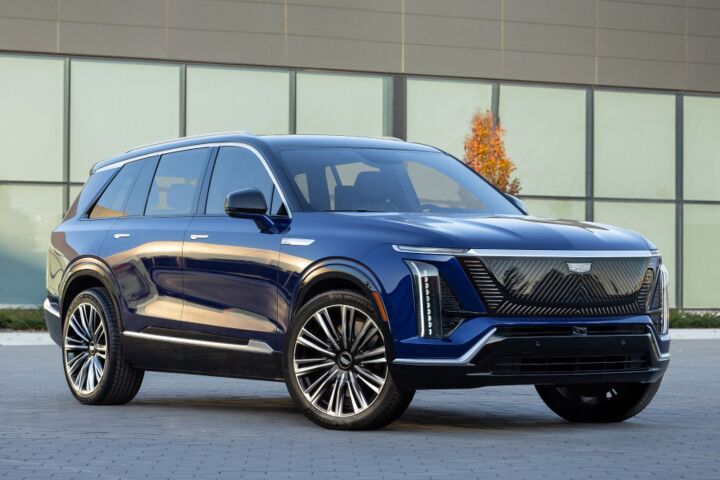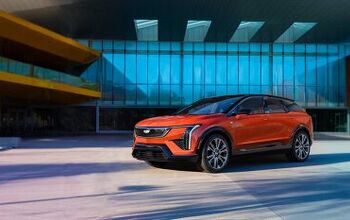Q-Tip: Cadillac Introduces 2026 Vistiq

The onslaught of all-electric vehicles into the Cadillac lineup continues unabated with the introduction of this, the three-row Vistiq.
Said to slot between the Lyriq and Escalade IQ, the Vistiq can be thought of as taking the XT6’s lot in life compared to that model’s stature against other gasoline-powered cars in the Cadillac showroom. Details such as power and battery size weren’t disclosed today but a quick glance at this car shown today reveals a ‘600’ badge on its rear hatch, a detail which provides plenty of clues.
In case you need a reminder, someone deep within the bowels of Cadillac thought it was a great idea to place badges on the rumps of all its vehicles indicating total torque output in newton-meters, rounded to the nearest 50th because why not. In this case, ‘600’ works out to roughly 450 lb-ft of twist, a sum (and badge) also appearing on the smaller two-row Lyriq crossover. With this in mind, there’s an excellent chance at least some trims of the Vistiq will have roughly 500 horsepower and 450 lb-ft torques.
In that Lyriq, a 102.0-kWh battery pack provides just over three hundred miles of driving range on a fully charged battery as per the federal eggheads measuring this type of stuff. As such, this larger and heavier three-row Vistiq could slide in just under the 300-mile limbo bar, a performance which would put it in line with the three-row Kia EV9. The fact we’re talking about Cadillac and Kia in the same breath is a development not lost on us.
Styling of the Vistiq takes much from its Escalade IQ larger brother, with a shield of sorts living on the front fascia where a grille would usually reside on a gasoline-powered car. Scads of LEDs line its face and will likely animate themselves in some sort of Vegas approximation when the owner approaches with key in pocket. Around back, the weirdo taillamp arrangement has been lifted almost wholesale from the Escalade IQ, creating a vertical look that’s separated about halfway up the D-pillar and massively flared at its bottom. This reminds us of the old Mirai, and not in a good way.
Promoted as a 2026 model, there’s a solid chance we’ll see this thing in the metal at an auto show sometime in the next calendar year - along with more items featuring the letter Q.
[Images: Cadillac, Toyota]
Become a TTAC insider. Get the latest news, features, TTAC takes, and everything else that gets to the truth about cars first by subscribing to our newsletter.

Matthew buys, sells, fixes, & races cars. As a human index of auto & auction knowledge, he is fond of making money and offering loud opinions.
More by Matthew Guy
Latest Car Reviews
Read moreLatest Product Reviews
Read moreRecent Comments
- Tassos Obsolete relic is NOT a used car.It might have attracted some buyers in ITS DAY, 1985, 40 years ago, but NOT today, unless you are a damned fool.
- Stan Reither Jr. Part throttle efficiency was mentioned earlier in a postThis type of reciprocating engine opens the door to achieve(slightly) variable stroke which would provide variable mechanical compression ratio adjustments for high vacuum (light load) or boost(power) conditions IMO
- Joe65688619 Keep in mind some of these suppliers are not just supplying parts, but assembled components (easy example is transmissions). But there are far more, and the more they are electronically connected and integrated with rest of the platform the more complex to design, engineer, and manufacture. Most contract manufacturers don't make a lot of money in the design and engineering space because their customers to that. Commodity components can be sourced anywhere, but there are only a handful of contract manufacturers (usually diversified companies that build all kinds of stuff for other brands) can engineer and build the more complex components, especially with electronics. Every single new car I've purchased in the last few years has had some sort of electronic component issue: Infinti (battery drain caused by software bug and poorly grounded wires), Acura (radio hiss, pops, burps, dash and infotainment screens occasionally throw errors and the ignition must be killed to reboot them, voice nav, whether using the car's system or CarPlay can't seem to make up its mind as to which speakers to use and how loud, even using the same app on the same trip - I almost jumped in my seat once), GMC drivetrain EMF causing a whine in the speakers that even when "off" that phased with engine RPM), Nissan (didn't have issues until 120K miles, but occassionally blew fuses for interior components - likely not a manufacturing defect other than a short developed somewhere, but on a high-mileage car that was mechanically sound was too expensive to fix (a lot of trial and error and tracing connections = labor costs). What I suspect will happen is that only the largest commodity suppliers that can really leverage their supply chain will remain, and for the more complex components (think bumper assemblies or the electronics for them supporting all kinds of sensors) will likley consolidate to a handful of manufacturers who may eventually specialize in what they produce. This is part of the reason why seemingly minor crashes cost so much - an auto brand does nst have the parts on hand to replace an integrated sensor , nor the expertice as they never built them, but bought them). And their suppliers, in attempt to cut costs, build them in way that is cheap to manufacture (not necessarily poorly bulit) but difficult to replace without swapping entire assemblies or units).I've love to see an article on repair costs and how those are impacting insurance rates. You almost need gap insurance now because of how quickly cars depreciate yet remain expensive to fix (orders more to originally build, in some cases). No way I would buy a CyberTruck - don't want one, but if I did, this would stop me. And it's not just EVs.
- Joe65688619 I agree there should be more sedans, but recognize the trend. There's still a market for performance oriented-drivers. IMHO a low budget sedan will always be outsold by a low budget SUV. But a sports sedan, or a well executed mid-level sedan (the Accord and Camry) work. Smaller market for large sedans except I think for an older population. What I'm hoping to see is some consolidation across brands - the TLX for example is not selling well, but if it was offered only in the up-level configurations it would not be competing with it's Honda sibling. I know that makes the market smaller and niche, but that was the original purpose of the "luxury" brands - badge-engineering an existing platform at a relatively lower cost than a different car and sell it with a higher margin for buyers willing and able to pay for them. Also creates some "brand cachet." But smart buyers know that simple badging and slightly better interiors are usually not worth the cost. Put the innovative tech in the higher-end brands first, differentiate they drivetrain so it's "better" (the RDX sells well for Acura, same motor and tranmission, added turbo which makes a notable difference compared to the CRV). The sedan in many Western European countries is the "family car" as opposed to micro and compact crossovers (which still sell big, but can usually seat no more than a compact sedan).
- Jonathan IMO the hatchback sedans like the Audi A5 Sportback, the Kia Stinger, and the already gone Buick Sportback are the answer to SUVs. The A5 and the AWD version of the Stinger being the better overall option IMO. I drive the A5, and love the depth and size of the trunk space as well as the low lift over. I've yet to find anything I need to carry that I can't, although I admit I don't carry things like drywall, building materials, etc. However, add in the fun to drive handling characteristics, there's almost no SUV that compares.




































Comments
Join the conversation
Would Cadillac EV fans be Diq's or just the haters?
Why is there a Toyota photo in the article?